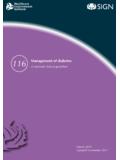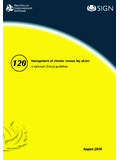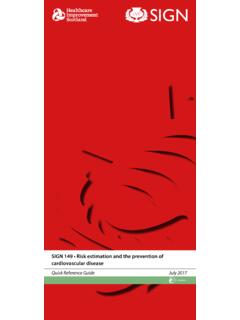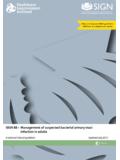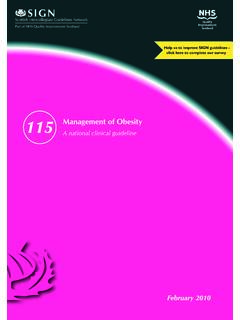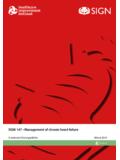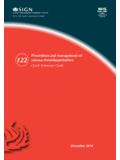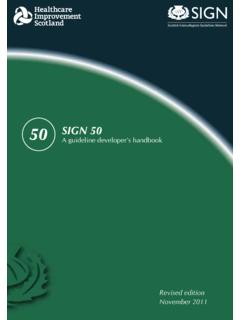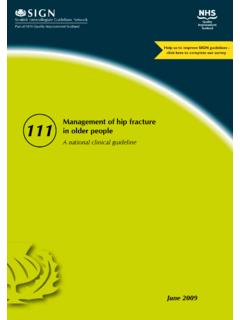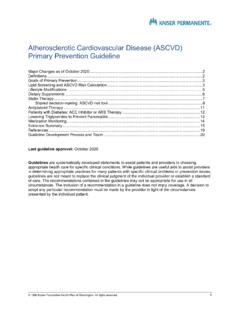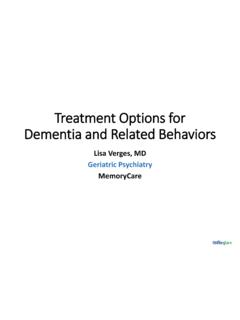Transcription of SIGN 148 • Acute coronary syndrome
1 SIGN 148 Acute coronary syndromeA national clinical guideline April 2016 EvidenceKEY TO EVIDENCE STATEMENTS AND RECOMMENDATIONSLEVELS OF EVIDENCE1++High-quality meta-analyses, systematic reviews of RCTs, or RCTs with a very low risk of bias1+Well-conducted meta-analyses, systematic reviews, or RCTs with a low risk of bias1 -Meta-analyses, systematic reviews, or RCTs with a high risk of bias2++ High-quality systematic reviews of case-control or cohort studies High-quality case-control or cohort studies with a very low risk of confounding or bias and a high probability that the relationship is causal2+Well-conducted case-control or cohort studies with a low risk of confounding or bias and a moderate probability that the relationship is causal2 - Case-control or cohort studies with a high risk of confounding or bias and a significant risk that the relationship is not causal3 Non-analytic studies, eg case reports, case series4 Expert opinionRECOMMENDATIONSSome recommendations can be made with more certainty than others.
2 The wording used in the recommendations in this guideline denotes the certainty with which the recommendation is made (the strength of the recommendation).The strength of a recommendation takes into account the quality (level) of the evidence. Although higher-quality evidence is more likely to be associated with strong recommendations than lower-quality evidence, a particular level of quality does not automatically lead to a particular strength of factors that are taken into account when forming recommendations include: relevance to the NHS in Scotland; applicability of published evidence to the target population; consistency of the body of evidence, and the balance of benefits and harms of the strong recommendations on interventions that should be used, the guideline development group is confident that, for the vast majority of people, the intervention (or interventions) will do more good than harm.
3 For strong recommendations on interventions that should not be used, the guideline development group is confident that, for the vast majority of people, the intervention (or interventions) will do more harm than conditional recommendations on interventions that should be considered , the guideline development group is confident that the intervention will do more good than harm for most patients. The choice of intervention is therefore more likely to vary depending on a person s values and preferences, and so the healthcare professional should spend more time discussing the options with the POINTS Recommended best practice based on the clinical experience of the guideline development has accredited the process used by Scottish Intercollegiate Guidelines Network to produce clinical guidelines. The accreditation term is valid until 31 March 2020 and is applicable to guidance produced using the processes described SIGN 50: a guideline developer s handbook, 2015 edition ( ).
4 More information on accreditation can be viewed at Improvement Scotland (HIS) is committed to equality and diversity and assesses all its publications for likely impact on the six equality groups defined by age, disability, gender, race, religion/belief and sexual guidelines are produced using a standard methodology that has been equality impact assessed to ensure that these equality aims are addressed in every guideline. This methodology is set out in the current version of SIGN 50, our guideline manual, which can be found at The EQIA assessment of the manual can be seen at The full report in paper form and/or alternative format is available on request from the Healthcare Improvement Scotland Equality and Diversity care is taken to ensure that this publication is correct in every detail at the time of publication. However, in the event of errors or omissions corrections will be published in the web version of this document, which is the definitive version at all times.
5 This version can be found on our web site This document is produced from elemental chlorine-free material and is sourced from sustainable Intercollegiate Guidelines NetworkAcute coronary syndromeA national clinical guidelineApril 2016 Acute coronary syndromeScottish Intercollegiate Guidelines Network Gyle Square, 1 South Gyle Crescent Edinburgh EH12 published April 2016 ISBN 978 1 909103 44 3 Citation textScottish Intercollegiate Guidelines Network (SIGN). Acute coronary syndrome . Edinburgh: SIGN; 2016. (SIGN publication no. 148). [April 2016]. Available from URL: consents to the photocopying of this guideline for the purpose of implementation in coronary syndromeContentsContents1 Introduction .. The need for a guideline .. Remit of the guideline .. Statement of intent ..42 Key recommendations .. Presentation, assessment and diagnosis .. Initial management.
6 Reperfusion therapy for ST-segment-elevation Acute coronary syndrome .. Early pharmacological intervention ..63 Presentation, assessment and diagnosis .. Clinical presentation and immediate assessment .. Biochemical diagnosis in ACS ..84 Initial management .. Service delivery .. cardiac monitoring .. Oxygen therapy .. Antiplatelet therapy .. Anticoagulant therapy .. Beta blockers .. Glycaemic control ..165 Reperfusion therapy for ST-segment-elevation Acute coronary syndrome .. Choice of reperfusion therapy .. Thrombolytic therapy .. Cost effectiveness of reperfusion therapies in ST-segment-elevation Acute coronary syndrome .. Rescue percutaneous coronary intervention .. Multivessel percutaneous coronary intervention ..206 Risk stratification and non-invasive testing .. Risk stratification .. Assessment of cardiac function .. Stress testing ..237 Invasive investigation and revascularisation.
7 Invasive investigation .. Access routes for percutaneous coronary intervention .. Glycoprotein IIb/IIIa receptor antagonists .. coronary artery bypass grafting surgery ..268 Early pharmacological intervention .. Antiplatelet therapy .. Anticoagulant therapy .. Statin therapy .. Beta-blocker and antianginal therapy .. Angiotensin-converting enzyme inhibitors .. Angiotensin receptor blockers .. Mineralocorticoid receptor antagonists ..32 Acute coronary syndromeAcute coronary syndrome9 Treatment of hypoxia and cardiogenic shock .. Non-invasive ventilation .. Intravascular volume loading and inotropic therapy .. Intra-aortic balloon counterpulsation .. coronary revascularisation .. cardiac surgery ..3410 Provision of Early psychosocial interventions .. Information needs of patients .. Sources of further information ..3711 Implementing the guideline .. Implementation strategy.
8 Resource implications of key recommendations .. Auditing current practice .. Additional advice to NHSS cotland from the Scottish Medicines Consortium ..4012 The evidence base .. Systematic literature review .. Recommendations for Review and updating ..4213 Development of the guideline .. Introduction .. The guideline development group .. The steering group .. Consultation and peer review ..45 Abbreviations ..46 Annexes .. | 1 Acute coronary syndromeAcute coronary syndrome1 Introduction THE NEED FOR A GUIDELINE coronary heart disease (CHD) is the single biggest cause of death in Scotland and the rest of the UK as well as being a major cause of premature mortality (death in people aged under 75). In Scotland in 2012, CHD accounted for 16% (n=4,258) of all deaths in men and 11% (n=3,283) of all deaths in women, and 17% (n=2,015) and 9% (n=738) of premature deaths in men and women, Myocardial infarction (MI), which together with unstable angina comprise Acute coronary syndrome (ACS), accounted for more than half of all deaths from CHD in Scotland in 2013/14 ( in men; 56% in women), with a third of these being in people under 75 years of age (44% in men and 21% in women).
9 2 The age-sex standardised incidence of MI in Scotland in 2013/14 was ,000 ( in men and in women), equating to 11,350 new cases of MI, 60% of them in men and 57% of them in people under 75 years of age. The incidence of MI in women under 75 years of age was less than half the corresponding rate in Thirty-day survival after a first emergency admission is very high, 93% for MI and 99% for unstable angina,2 although longer-term prognosis remains poor for some subgroups of patients (see section ). UPDATING THE EVIDENCE This guideline updates SIGN 93, first published in February 2007, and updated in February 2013, to reflect the most recent evidence. Where no new evidence was identified to support an update, text and recommendations are reproduced verbatim from SIGN 93. The original supporting evidence was not reappraised by the current guideline development group.
10 REMIT OF THE GUIDELINE OVERALL OBJECTIVES This guideline provides recommendations for the management of patients with an ACS within the first 12 hours and up to hospital discharge. With the exception of dual antiplatelet therapy with aspirin and P2Y12-receptor antagonists (see section ), this guideline does not make recommendations for long-term treatment following discharge from hospital. This guideline does not make recommendations for prehospital management, for example by ambulance service personnel, but refers to prehospital management where appropriate (for example, see section 4). The guideline does not address the management of undifferentiated chest pain or Acute heart failure although the treatment of hypoxia and cardiogenic shock in patients with ACS is considered in section 9. DEFINITION OF Acute coronary syndrome Acute coronary syndrome encompasses a spectrum of unstable coronary artery disease from unstable angina to transmural myocardial infarction.

